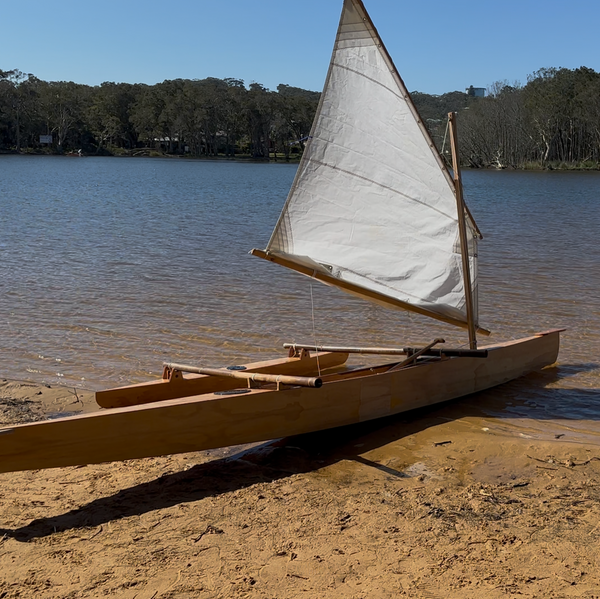
It's no surprise stand up paddle boarding has surged in popularity in recent years, offering a unique combination of the outdoors, exercise, and adventure on the water.
Most paddlers choose a factory fibreglass board or (heaven forbid!) an inflatable board, however there's a growing trend of DIY enthusiasts taking a different path and building their own wooden paddle boards.

Right: Launch of Bryan Gillis' Cutwater paddle board in Western Australia.
Contrary to popular belief, building a wooden stand up paddle board is not difficult – just about anyone can do it with the right plans. Here's why...
Accessibility of Plans:
Thanks to the internet, finding detailed plans for building a wooden stand up paddle board has never been easier. Numerous websites and online communities offer step-by-step instructions, blueprints, and video tutorials that guide builders through the process from start to finish. These plans cater to various skill levels, ensuring that even beginners can embark on the project with confidence.

The key is finding a set of plans that matches your skill level, this is where Vintage Board Co. plans have found a following. Our plans are designed so that just about anyone with limited knowledge of woodworking can build a beautiful yet great paddling wooden paddle board.
Our design philosophy is 'build simple, build beautiful'.
Minimal Tools and Materials:
Unlike traditional boat building, constructing a wooden paddle board requires minimal tools and materials. Basic woodworking tools such as a jigsaw or circular saw, sander, drill, and clamps are sufficient for the job, making it accessible to hobbyists with limited equipment.
Additionally, the materials needed – marine plywood, epoxy resin, fibreglass cloth, and polyurethane glue – are readily available at hardware stores or from online suppliers, making the project both affordable and accessible. In fact you can even use exterior grade plywood if you can't get hold of the higher quality marine plywood, so long as it's well protected with epoxy and paint/varnish.
 Left: here's some cheap and simple PVC pipe rings used as effective claps used in the construction of this Wombat paddle board.
Left: here's some cheap and simple PVC pipe rings used as effective claps used in the construction of this Wombat paddle board.
Strong but light Construction:
Our wooden paddle board plans use the proven 'stitch & glue' construction method broken down into manageable steps. Builders start by cutting out the frames, hulls sides and bottom panels as per the instructions. Then stitch the wooden parts together with copper wire, adding epoxy and fibreglass to create a lightweight yet durable board.
This construction approach simplifies the building process, allowing builders to tackle one stage at a time and progress at their own pace.

Above: here you can see the frames and deck stringers. The deck is glued with epoxy to this internal framework turning individual components into one strong load bearing structure.
Customisation Options:
Building your own wooden paddle board offers unparalleled opportunities for customisation. From choosing the right plans for the shape of the board to adding personal touches such as artwork or inlays, builders have full control over the final product. Whether you prefer a classic varnished timber finish or a custom painted board, the ability to tailor the board to your preferences ensures a truly unique and personalized end result. You can even add sails and set up your board for fishing!
Above: The author's fun lockdown project of adding a furling sail to a plywood stand up paddle board. The sail was bought from Star Kayak Sails.
Sense of Achievement:
There's an undeniable sense of achievement that comes from crafting something with your own hands – and building a wooden paddle board is no exception.
Get ready for all the comments and admiring glances you'll get whenever you hit the water. I can guarantee you'll get questions like, "Wow! Did you build that?", "Where can I get the plans?"
As builders progress through each stage of the construction process, they develop new skills, overcome challenges, and gain a deeper appreciation for the craftsmanship involved. The moment when the finished board finally hits the water is a moment of pride and satisfaction that can't be replicated.

Left: Andrew's beautifully built Wombat paddle board, complete with printed Wombat decal on the nose!
Community Support:
The DIY wooden paddle board community is a welcoming and supportive network of enthusiasts who are eager to share knowledge, tips, and encouragement.
Our Facebook builders group is a great way for builders to connect with like-minded individuals, seek advice, and celebrate their accomplishments. This sense of community fosters camaraderie and inspiration, fuelling the passion for DIY paddle board building.

Above: The Vintage Board Co. paddle board builders forum is a friendly group of like minded paddle board builders sharing their experiences and projects.
Why wait? Get building!
Building your own wooden stand up paddle board is a rewarding and achievable project for just about anyone with the right plans. With accessibility to detailed instructions, minimal tools and materials, proven construction techniques, customization options, a sense of achievement, and a supportive community, there's never been a better time to embark on the adventure of crafting your own wooden SUP board.
So why wait? Dive in, embrace the challenge, and unlock the joy of paddling on a board that you built with your own two hands!
Encontre artigos semelhantes
Paddle board sailingStand up paddle board plansStand up paddle boardingWooden stand up paddle board




